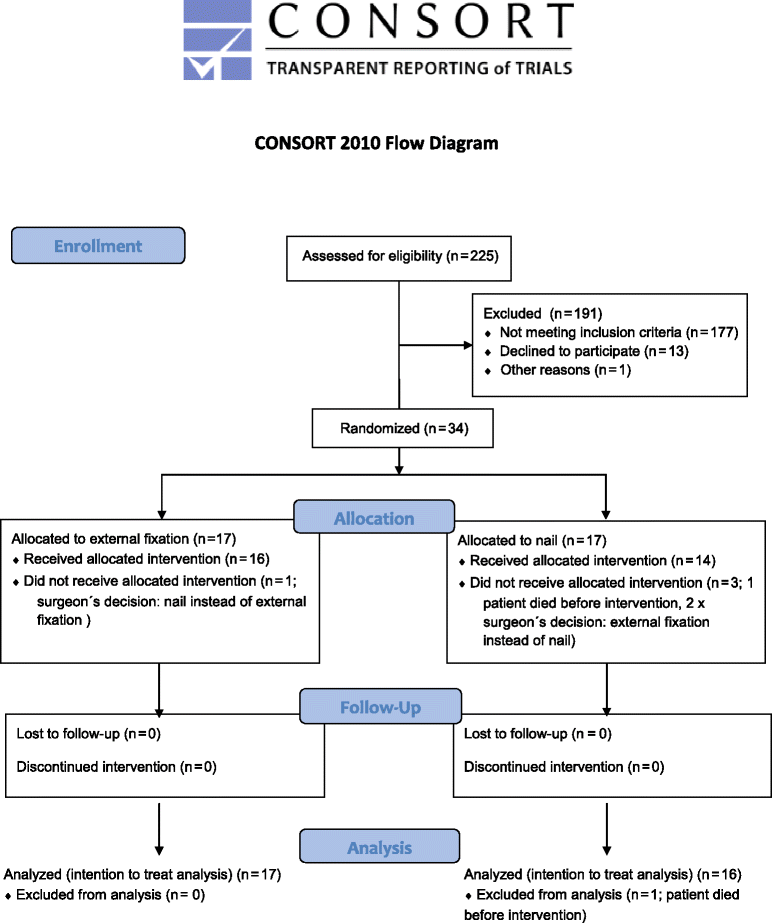Randomized, controlled, two-arm, interventional, multicenter study on risk-adapted damage control orthopedic surgery of femur shaft fractures in multiple-trauma patients
- PMID: 26809247
- PMCID: PMC4727266
- DOI: 10.1186/s13063-016-1162-2
Randomized, controlled, two-arm, interventional, multicenter study on risk-adapted damage control orthopedic surgery of femur shaft fractures in multiple-trauma patients
Abstract
Background: Long bone fractures, particularly of the femur, are common in multiple-trauma patients, but their optimal management has not yet been determined. Although a trend exists toward the concept of "damage control orthopedics" (DCO), current literature is inconclusive. Thus, a need exists for a more specific controlled clinical study. The primary objective of this study was to clarify whether a risk-adapted procedure for treating femoral fractures, as opposed to an early definitive treatment strategy, leads to an improved outcome (morbidity and mortality).
Methods/design: The study was designed as a randomized controlled multicenter study. Multiple-trauma patients with femur shaft fractures and a calculated probability of death of 20 to 60 % were randomized to either temporary fracture fixation with external fixation and defined secondary definitive treatment (DCO) or primary reamed nailing (early total care). The primary objective was to reduce the extent of organ failure as measured by the maximum sepsis-related organ failure assessment (SOFA) score.
Results: Thirty-four patients were randomized to two groups of 17 patients each. Both groups were comparable regarding sex, age, injury severity score, Glasgow Coma Scale, prothrombin time, base excess, calculated probability of death, and other physiologic variables. The maximum SOFA score was comparable (nonsignificant) between the groups. Regarding the secondary endpoints, the patients with external fixation required a significantly longer ventilation period (p = 0.049) and stayed on the intensive care significantly longer (p = 0.037), whereas the in-hospital length of stay was balanced for both groups. Unfortunately, the study had to be terminated prior to reaching the anticipated sample size because of unexpected low patient recruitment.
Conclusions: Thus, the results of this randomized study reflect the ambivalence in the literature. No advantage of the damage control concept could be detected in the treatment of femur fractures in multiple-trauma patients. The necessity for scientific evaluation of this clinically relevant question remains.
Trial registration: Current Controlled Trials ISRCTN10321620 Date assigned: 9 February 2007.
Figures
References
-
- Dunham CM, Bosse MJ, Clancy TV, Cole FJ, Jr, Coles MJM, Knuth T, et al. Practice management guidelines for the optimal timing of long-bone fracture stabilization in polytrauma patients: the EAST Practice Management Guidelines Work Group. J Trauma. 2001;50:958–67. doi: 10.1097/00005373-200105000-00037. - DOI - PubMed
-
- Deutsche Gesellschaft für Unfallchirurgie. S3-Leitlinie Polytrauma/ Schwerverletzten-Behandlung, 2011. http://www.awmf.org/leitlinien/detail/II/012-019.html. Access date 23 January 2016.
-
- Rixen D, Grass G, Sauerland S, Lefering R, Raum MR, Yücel N, et al. Evaluation of criteria for temporary external fixation in risk-adapted damage control orthopedic surgery of femur shaft fractures in multiple trauma patients: “evidence-based medicine” versus “reality” in the trauma registry of the German Trauma Society. J Trauma. 2005;59:1375–95. doi: 10.1097/01.ta.0000198364.50334.39. - DOI - PubMed
Publication types
MeSH terms
Associated data
LinkOut - more resources
Full Text Sources
Other Literature Sources
Medical





